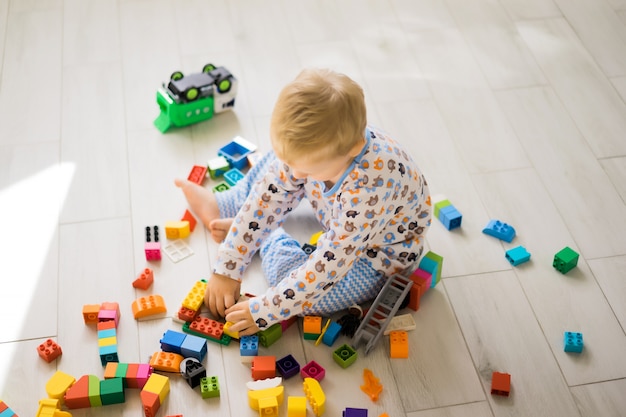¿Los niños y niñas pequeños se comportan por igual?
¿Los niños son más inquietos y las chicas más tranquilas?
¿Son verbalmente más enérgicos y más competentes?
Cuando nace el bebé, su cerebro tiene cien mil millones de neuronas. Las conexiones entre las neuronas o sinapsis comienzan a formarse: solo el 10% de ellas están presentes en el momento del nacimiento; el 90% restante se construirá más tarde. En los procesos del desarrollo del cerebro, los estímulos ambientales son esenciales para guiar el establecimiento de redes neuronales para asegurar las principales funciones sensoriales, motoras y cognitivas.
Es el medio ambiente como un todo el que participa e influye en la construcción del cerebro. Gracias a las nuevas técnicas de imágenes cerebrales, como la resonancia magnética, podemos ver que el cerebro cambia según el aprendizaje y la experiencia.
¡Cuánto cambiamos!
https://www.pinterest.es/maestroUsero/neuroscience%2Beducation-neurociencia%2Beducacion/
Es importante dejar al niño libre en sus elecciones, porque sus opciones son un reflejo de lo que se encuentra en la sociedad. Un niño que juega con la muñeca también es un niño que se familiariza con el papel de un padre. Si el niño es el tipo contemplativo, es preferible respetar esta faceta de su personalidad en lugar de la fuerza, por ejemplo, para participar en la práctica de un deporte.
Por ejemplo, las niñas son en promedio mejores que los niños en lectura, escritura y fluidez verbal, mientras que los niños son mejores en las pruebas que requieren manipulación y uso de representaciones en el espacio. Los resultados en la memoria se comparten, las diferencias de sexo van en direcciones opuestas, dependiendo de los tipos de memoria.
Las diferencias
Los cerebros de los niños y niñas son diferentes: por ejemplo, la corteza cerebral, lo que determina la inteligencia, se desarrolla primero en fetos femeninos, sobre todo el lado izquierdo, responsable del pensamiento. Por otro lado, el peso y el volumen del cerebro del niño son de 10 a 15% más altos que los de la niña. Los estudios de imágenes cerebrales (MRI) indican que algunas áreas crecen más rápido en el cerebro femenino, mientras que otras crecen más rápido en el cerebro masculino:
* El lóbulo cerebral izquierdo de los niños (el área responsable del control del pensamiento) se desarrolla más lentamente que el derecho (el oficial de control espacial). Gracias a esta maduración asimétrica de los lóbulos cerebrales, los niños son más hábiles en matemáticas y menos en lenguaje y literatura.
* Las niñas tienen una maduración cerebral más homogénea. Los dos lóbulos cerebrales maduran al mismo tiempo, lo que permite que ambos hemisferios se utilicen para la lectura y la conciencia emocional.
* El cerebro femenino secreta más serotonina, un neurotransmisor que, entre sus funciones, es responsable de inhibir la agresividad.
* El cerebro masculino produce mayores cantidades de testosterona, una hormona que promueve la agresividad.
Los cerebros de los niños y niñas de la misma edad podrían estar en diferentes etapas de desarrollo. Sin embargo, con el tiempo uno se une al otro.
El impacto biológico
Los últimos estudios muestran que las hormonas tienen un impacto en el desarrollo del cerebro, especialmente en la orientación espacial y el lenguaje.
Estas diferencias anatómicas están en el origen de las diferencias de comportamiento y no de las diferencias intelectuales. Cada sexo evoluciona a un ritmo diferente y desarrolla habilidades en diferentes áreas.
El desarrollo del cerebro en el niño del feto en el útero es estimulado por la testosterona. Un estudio de la Universidad de Maryland descubrió que los recién nacidos tienen el mismo nivel de testosterona que un varón adulto. Se desvanece rápidamente y no comenzará a aumentar nuevamente hasta la pubertad, pero la presencia de testosterona en el desarrollo fetal influye en el cerebro al "fortalecer" ciertas áreas, como el razonamiento espacial. Las niñas también tienen testosterona, pero en una cantidad mucho menor que los niños.
Aparentemente, es la testosterona responsable de la "masculinización" del cerebro, la razón por la cual los niños tienen más habilidades que las niñas pequeñas, el aspecto motor y la percepción visual (visión profunda) que las niñas durante la infancia. Por ejemplo, esta habilidad para ponerse debajo de una mesa cuando camina a cuatro patas.
Se ha demostrado que, en el desarrollo del lenguaje, las hormonas femeninas son un factor facilitador. Es decir, el estrógeno tiene influencia en el desarrollo del cerebro, lo que facilita el desarrollo del lenguaje. Esta es la razón por la cual las niñas tienen más facilidades de comunicación que los niños y desarrollan el lenguaje más rápidamente.
La amígdala está más desarrollada en el niño pequeño, un área del cerebro, situada cerca del lóbulo temporal, donde se generan y controlan emociones fuertes. Los niños reaccionan con emociones e impulsos más fuertes y fuertes, como la agresión.
Algunos estudios informan que el área del cerebro responsable de controlar las emociones y el lenguaje, el núcleo caudal, tiende a ser más grande en las niñas pequeñas.
El cuerpo calloso, la estructura que se encuentra en la mitad del cerebro y permite la conexión entre los dos hemisferios, es funcional antes en la niña, y generalmente muestran mejores habilidades de lectura.
Las niñas tienen más capacidad para realizar ciertas tareas al mismo tiempo, mientras que para los niños es más complicado. Los estudios sugieren que esto puede deberse al hecho de que el cuerpo calloso es más grande en las niñas que en los niños. Cuanto mejores sean las conexiones de los callos del cuerpo, más hábiles serán en hacer las cosas simultáneamente.
El desarrollo del hemisferio izquierdo, más avanzado en la niña, le confiere mejores habilidades relacionadas con el lenguaje. En cuanto al niño, su hemisferio derecho tiene más conexiones nerviosas, lo que podría explicar por qué tienen una mejor percepción espacial.
La corteza de las niñas se agrava dramáticamente en algunas áreas clave involucradas en el control emocional y del lenguaje. Esto hace que las niñas hablen mejor y antes que los niños.
La corteza de los niños se vuelve más gruesa que la de las niñas en áreas dedicadas a la visualización tridimensional y las operaciones mentales, como las rotaciones virtuales de objetos complejos.
El impacto biológico
Los últimos estudios muestran que las hormonas tienen un impacto en el desarrollo del cerebro, especialmente en la orientación espacial y el lenguaje.
Estas diferencias anatómicas están en el origen de las diferencias de comportamiento y no de las diferencias intelectuales. Cada sexo evoluciona a un ritmo diferente y desarrolla habilidades en diferentes áreas.
El desarrollo del cerebro en el niño del feto en el útero es estimulado por la testosterona. Un estudio de la Universidad de Maryland descubrió que los recién nacidos tienen el mismo nivel de testosterona que un varón adulto. Se desvanece rápidamente y no comenzará a aumentar nuevamente hasta la pubertad, pero la presencia de testosterona en el desarrollo fetal influye en el cerebro al "fortalecer" ciertas áreas, como el razonamiento espacial. Las niñas también tienen testosterona, pero en una cantidad mucho menor que los niños.
Aparentemente, es la testosterona responsable de la "masculinización" del cerebro, la razón por la cual los niños tienen más habilidades que las niñas pequeñas, el aspecto motor y la percepción visual (visión profunda) que las niñas durante la infancia. Por ejemplo, esta habilidad para ponerse debajo de una mesa cuando camina a cuatro patas.
Se ha demostrado que, en el desarrollo del lenguaje, las hormonas femeninas son un factor facilitador. Es decir, el estrógeno tiene influencia en el desarrollo del cerebro, lo que facilita el desarrollo del lenguaje. Esta es la razón por la cual las niñas tienen más facilidades de comunicación que los niños y desarrollan el lenguaje más rápidamente.
La amígdala está más desarrollada en el niño pequeño, un área del cerebro, situada cerca del lóbulo temporal, donde se generan y controlan emociones fuertes. Los niños reaccionan con emociones e impulsos más fuertes y fuertes, como la agresión.
Algunos estudios informan que el área del cerebro responsable de controlar las emociones y el lenguaje, el núcleo caudal, tiende a ser más grande en las niñas pequeñas.
El cuerpo calloso, la estructura que se encuentra en la mitad del cerebro y permite la conexión entre los dos hemisferios, es funcional antes en la niña, y generalmente muestran mejores habilidades de lectura.
Las niñas tienen más capacidad para realizar ciertas tareas al mismo tiempo, mientras que para los niños es más complicado. Los estudios sugieren que esto puede deberse al hecho de que el cuerpo calloso es más grande en las niñas que en los niños. Cuanto mejores sean las conexiones de los callos del cuerpo, más hábiles serán en hacer las cosas simultáneamente.
El desarrollo del hemisferio izquierdo, más avanzado en la niña, le confiere mejores habilidades relacionadas con el lenguaje. En cuanto al niño, su hemisferio derecho tiene más conexiones nerviosas, lo que podría explicar por qué tienen una mejor percepción espacial.
La corteza de las niñas se agrava dramáticamente en algunas áreas clave involucradas en el control emocional y del lenguaje. Esto hace que las niñas hablen mejor y antes que los niños.
La corteza de los niños se vuelve más gruesa que la de las niñas en áreas dedicadas a la visualización tridimensional y las operaciones mentales, como las rotaciones virtuales de objetos complejos.
Las chicas hablan mejor que los chicos
Investigadores de la Universidad de Northwestern en los Estados Unidos y la Universidad de Haifa en Israel han auscultado a la luz de la imagen por resonancia magnética (MRI) y se encontró que en los varones, el lenguaje hablado y el lenguaje escrito no estimula las mismas regiones del cerebro.
Empiezan a hablar antes, adquieren vocabulario más rápido y hablan más espontáneamente. Las niñas están mejor equipadas que los niños para hablar, escribir o leer.
Las niñas muestran más actividad que los niños en algunos centros de idiomas, mientras que los niños activan áreas adicionales en función de la modalidad visual o auditiva en la que se les presenta la información. Por lo tanto, no importa si las palabras se leen o se escuchan, las niñas convierten la información en pensamiento abstracto, derrotado de su contexto de aprendizaje. Para los niños, dependiendo de si la información es hablada o leída, no la recordarán de la misma manera; está filtrado Los investigadores también encontraron que en las pruebas de Q.I, las niñas se desempeñaron mejor.
Los autores concluyen que los niños activan las áreas cerebrales relacionadas con la percepción sensorial. Dependiendo de si se ve o escucha la palabra, el niño usa su sistema visual o auditivo. Las niñas, por otro lado, en ambos casos utilizan las mismas regiones del cerebro, las relacionadas con el análisis del lenguaje, que leen o escuchan. Más específicamente, los resultados de las pruebas se correlacionaron, en las niñas, con la activación mayor o menor de estas áreas del lenguaje.
Según los autores, estas diferencias no necesariamente persistirían en los adultos. Principalmente reflejarían un cambio en la madurez cerebral entre niñas y niños de la misma edad, el último mostrando un desarrollo más lento.
Los chicos retienen lo esencial. Para que los niños retengan la información a la perfección, debe leerla y escribirla al mismo tiempo. Los niños reaccionan a las asociaciones. Ven un objeto o una palabra y les hace pensar en algo. Cualquier información adicional se experimenta como una distracción de la información principal.
Impacto social
La ciencia moderna tiende a mostrar que las diferencias entre niños y niñas se derivan esencialmente de la sociedad.
Las interacciones con el entorno determinarían la esencia de la construcción del cerebro.
La socialización de género se refiere al proceso mediante el cual los niños aprenden las expectativas, actitudes y comportamientos sociales típicamente asociados con niños y niñas.
Los estudios muestran que la mayoría de las diferencias psicológicas entre niñas y niños provienen de la educación y las actitudes sociales. Los adultos tienen una actitud diferente hacia ambos sexos. Por ejemplo, las niñas se hablan con más frecuencia, lo que mejora la adquisición de sus habilidades verbales. Mientras que con los niños, la fuerza física se valora y la agresión física es más tolerada. Las chicas también son agresivas, pero de lo contrario. Desde la edad de 4 años, practican una agresión más indirecta (y verbal), como hablar en la espalda o montar un grupo en contra de alguien.
En cuanto a otras habilidades sociales como el intercambio, la cooperación y la empatía, las diferencias serían menores. Un estudio realizado en la Universidad Laval llegó a esta conclusión al observar niños pequeños de 4 años. Aunque los educadores vieron a las niñas como más sociables que los niños, los investigadores no encontraron diferencias significativas en los comportamientos de los niños.
Niños
1. Son más impulsivos y preocupados.
2. Están menos ordenados.
3. Tienden a buscar la gratificación inmediata. Comen rápido, saltan de una actividad a otra.
4. Se concentran inmediatamente en resolver un problema, incluso en una situación muy emocional.
5. Prefieren participar en actividades que crean tensión (un deporte, una pelea y juegos) que les permite liberar energía.
6. Se centran en una tarea y reaccionan de forma más agresiva a las interrupciones.
7. Participan en juegos que requieren más espacio.
8. Necesitan estar afuera por más tiempo.
9. Tienen un mejor razonamiento aritmético.
10. Destacan en habilidades mecánicas y visoespaciales.
11. Tienen mayores dificultades para expresar sus sentimientos.
12. Pueden tener problemas con la disciplina y la agresión.
Niñas
1. Las actividades motoras de las niñas son más lentas, menos vigorosas.
2. Usan más de los cinco sentidos.
3. Tienen una mayor fluidez verbal, su lenguaje aparece y se desarrolla antes que el de los niños.
4. Tienen instalaciones para el cálculo aritmético.
5. Tienen mejores habilidades manuales: un mejor control de la muñeca y los dedos es una buena psicomotricidad (aprenden a abotonar y desabotonar delante de los niños).
6. Aprenden a vestirse solos antes y mejor que los niños.
7. Son más hábiles en todos los trabajos que requieren destreza y velocidad manual.
8. Destacan en la percepción rápida de detalles y en tareas que implican atención y memoria.
9. Tienen una mejor coordinación física y un desarrollo anterior.
10. Se calman más fácilmente de su enojo.
11. Son más expresivos en lenguaje verbal y gestual.
12. Son más disciplinados, obedientes y, en general, más callados.
Las diferencias que inicialmente existen entre el cerebro de una niña pequeña y el cerebro de un niño pequeño son mínimas. Parece que, en general, los niños pequeños realizan sus etapas de maduración más tarde que las niñas. Esto no significa que tengan menos éxito, sino solo que tengan una tasa de crecimiento diferente.









